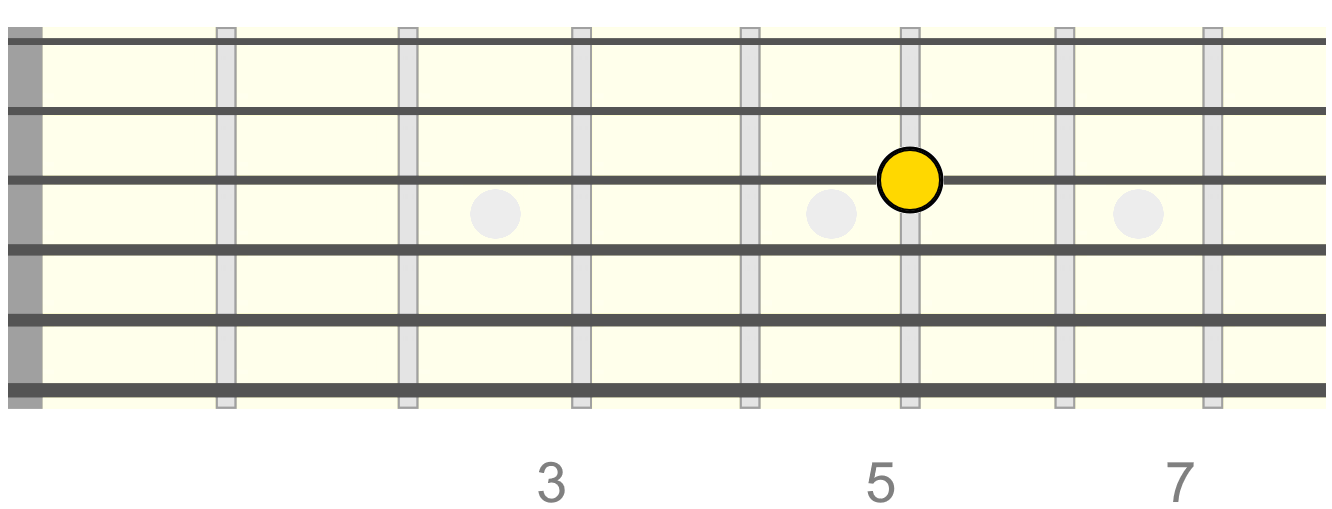It's useful to know how to tune a guitar using harmonics if you want a quick and accurate tuning reference and don't have an electronic tuner immediately at hand.
This particular method isn't used as much as the 5th fret method because it takes a little longer to master. But hopefully by the end of this lesson you'll be ready to use it for life!
Similar to the 5th fret method, harmonic tuning tunes the guitar to itself, almost perfectly (tuning can never be 100% perfect on a fretted instrument made of wood!). This is known as relative tuning.
Typically, guitarists will use this method to fine tweak their tuning, maybe on just one rebellious string between songs/jams. It's an efficient, quick fire way of fine tuning a mostly tuned guitar.
Harmonic tuning uses the open string harmonics of your guitar (also known as "natural harmonics"). You can tell a harmonic from its high pitched resonance. Take a listen...
We're going to be using these harmonics across string pairings to tune our guitar. But first, if you don't already know, here's how to get the harmonic...
Getting the Harmonic
Let's initially try this at the 5th fret on the 3rd string.
Position your finger as though you're about to fret the string, but instead of positioning it over the fret space you need to position it directly over the fret wire.
Now, instead of pressing down to fret the string as usual, hold the tip of your finger over the string, barely touching it. The top part of your finger should just brush over the top of the string.
Remember to keep your finger in line with the fret wire. The yellow spot in the diagram below is the spot you want here...

Now pick the string as usual with your pick hand and, as soon as you hit the string, immediately pull your fret hand finger away.
You should hear something like this ring out...
However...
If you're instead hearing this...
...then your finger is not quite touching the string enough or you're pulling away too soon. It just sounds like the open string is being picked (not the harmonic).
If you're hearing this...
...then you're not pulling your finger away quick enough after you've picked the string. The string is being muted by your finger. Also, check your finger is positioned over the fret wire and not the space between the fret wires.
Tip: try and hit the string with the very tip of your plectrum to get the sharpest strike possible - this will enhance the harmonic's presence.
I know it's trite to say, but "practice makes perfect". The more you train your finger to position accurately as outlined above, the quicker you'll be able to throw out a harmonic when you need it (they also sound pretty cool to throw in a song occasionally).
Let's now look at how to use these harmonics on all strings to accurately tune our guitar...
Tuning Up the Guitar Using Harmonics
Starting with the low E/6th string, this will be our base, as this method of tuning is about "tuning the guitar to itself", also known as relative tuning.
It's useful, however, to know roughly what a low E should sound like (over time, you'll be able to get a closer approximation of perfect pitch).
At the 5th fret wire we're going to use the harmonic technique outlined above for the 6th string. Once the harmonic is ringing out from the E string, play the 5th (A) string harmonic at the 7th fret.

Both harmonics should be allowed to ring out together, like this...
Now, when you've struck the harmonic for both these strings, and it's ringing out for both at the same time, you'll hear a kind of "swelling" effect, as if the note is oscillating. If it's already tuned perfectly, however, you won't hear this effect.
What you need to do is listen for this oscillating sound between the two harmonics and tune the higher of the two strings up or down until the vibration becomes slower and slower... until it flatlines.
Listen really closely to this next clip and hear the wobble!
Did you hear it? Turn your volume up and you'll hear me tuning the 5th string up until the harmonic vibration is straightened out. This occurs when the discrepancy between the two notes becomes a perfect unison (or at least perfect to our ears).
If the 5th string is tuned too high, it will create a similar oscillating effect, but you should tune down first and then back up (this is because tuning up helps to lock the string's tension, keeping it in tune longer).
Again, listen closely for the pitch discrepancy and vibration effect...
So, once you get the harmonics of 5th fret E string and 7th fret A string nice and constant, the two strings should be tuned to each other perfectly, or at least almost perfectly!
What about the other strings?
Well, follow the same procedure with the 5th (A) and 4th (D) string pairing (tuning the 4th string up or down), and then the 4th and 3rd (G) string pairing (tuning the 3rd string up or down).
The blue dot indicates the string you need to tune up or down to straighten out the harmonic. If working up from the lowest, 6th string, the string you tune is always the higher of the two (there is a caveat to this which I'll cover later).
Tuning the 4th String
- 5th string harmonic at 5th fret
- 4th string harmonic at 7th fret

Tuning the 3rd String
- 4th string harmonic at 5th fret
- 3rd string harmonic at 7th fret

Tuning the 2nd String
Now, when we get to the 2nd (B) string, the tuning interval changes.
All we need to do is change the position of the lower harmonic, which will be back to the 6th string as the reference pitch, and then tuning the open 2nd string to match it. See the diagram below...
- 6th string harmonic at 7th fret
- 2nd string open

Tuning the 1st String
And finally, back to the same 5th-7th fret pairing as before for tuning the 1st (E) string...
- 2nd string harmonic at 5th fret
- 1st string harmonic at 7th fret

You should now have a well tuned (at least to itself) guitar! Strum a few chords and tweak as necessary.
Using harmonics can be a very quick and accurate way to tune up your guitar if you don't need perfect pitch (e.g. you're just having a quick, impromptu noodle), but it's not known by many guitarists.
Learning to play harmonics also comes in handy with lead guitar, as an interesting effect you can use, especially powerful under high gain/distortion, so it's a versatile technique to master.
Nuanced Tuning Situations
Sometimes you might want to use this method to fine tune the lower string, rather than the upper string in the harmonic pairing.
For this, you'll need to be able to identify which is the rebellious string out of the six in terms of tuning discrepancy, perhaps testing it both against the upper and lower string harmonic. If the harmonic is consonant between a string and its upper adjacent string, for example, but dissonant against its lower adjacent string, then chances are it's the lower string that needs adjustment. You can test this by checking other harmonic string pairings as a process of elimination.
The 6th string tends to hold its tuning throughout a playing session more effectively than the higher strings. So as long as you start with an accurately tuned 6th string, this method is pretty reliable from the 6th string up, as you work through that process of elimination. That's why we used the earlier "ground up" process.
You might be wondering "why not just use an electronic tuner every time?" Good question! There have been countless situations in which it was just more convenient for me to use harmonics to quickly fix a tuning discrepancy. For example, you reach for your acoustic on the porch or at a camp fire, no tuner immediately at hand - it's pretty much tuned but there's one string that sounds a little off. Situations like that will happen!
Also, tuning can be seen as a collective "army" of methods. Electronic, harmonic, 5th fret etc. They can all work together as a grand, fine tuning collective in different situations.
